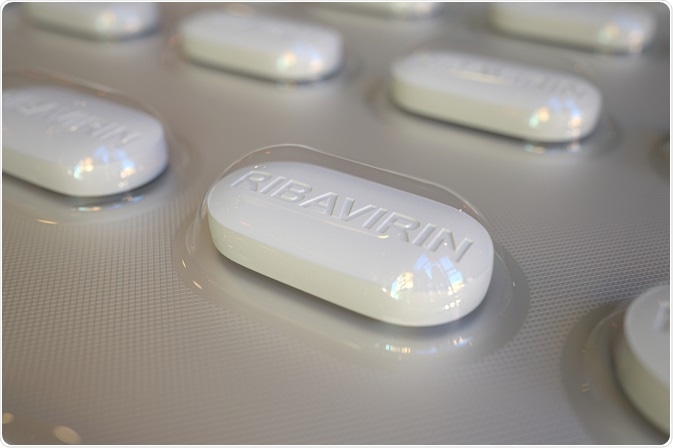Ribavirin is a broad-spectrum antiviral agent predominantly used in the treatment of hepatitis C and respiratory syncytial virus (RSV) infections. The exerted antiviral effect depends substantially on the dosage and plasma concentration of the drug, thus its pharmacokinetic properties (together with the underlying mechanisms of action) may be the key to the identification of improved therapeutic protocols.
After oral ingestion of ribavirin (which is the most typical route of administration), the plasma concentration exhibits a characteristic three-phase profile, consisting of two rapid phases (absorption and distribution) and one long terminal elimination phase.

Image Credit: Novikov Aleksey / Shutterstock
Absorption phase
Ribavirin is promptly absorbed into circulation, with the help of gastrointestinal, sodium-dependent nucleoside transporters in the proximal small bowel. Peak concentrations are achieved approximately 2.5 hours after dosing, with a concentration range between 1.7 and 5.3 µM following oral administration of 1000 mg/day.
After multiple dosing schedules, ribavirin accumulates in plasma gradually and reaches a maximum asymptotic concentration in roughly four weeks. The bioavailability of ribavirin increases significantly with high-fat meals, and adenine kinase enzyme (which is more active in virally infected cells) is required to convert the drug into the active nucleotide form.
Distribution phase
Oral ribavirin is systematically distributed after intestinal absorption facilitated by nucleoside transporters on the luminal epithelial cells. There are two major families of nucleoside transporters, which are distinguished by the energetics of the transport. Those are the concentrative nucleoside transporters (CNTs) and the equilibrative nucleoside transporters (ENTs).
The consensus is that the rapid distribution phase is attributed to the distribution of ribavirin into tissues such as striated muscles and erythrocytes, and the long terminal half-life is attributed to the slow redistribution of ribavirin out of these peripheral compartments.
The intracellular concentration of ribavirin reaches the extracellular concentration in less than one minute, at which value the former saturates. Therefore this drug shows a saturable influx mechanism with a mean Michaelis-Menten-like constant of 440 µM at 22 ºC.
The aforementioned transporters are also used to enter striated muscles and erythrocytes. Inside the cell, ribavirin is reversibly or irreversibly phosphorylated (depending on whether a cell contains a nucleus or not). The volume of distribution at the steady-state of ribavirin is approximately 650-1100 liters.
Elimination phase
Ribavirin is eliminated by metabolism and renal elimination, with the latter accounting for about 5–15% of single-dose elimination. Approximately one-third of absorbed ribavirin is excreted into the urine unchanged, whereas the rest is excreted as deribosylated base 1,2,4-triazole 3-carboxamide, and its hydrolysis product, 1,2,4-triazole 3-carboxylic acid.
The elimination of the drug from erythrocytes is extremely slow with a half-life of 40 days, suggesting that removal is due to splenic hemolysis. One consequence of this slow elimination might be the lengthened terminal elimination phase of plasma ribavirin pharmacokinetics.
Liver function does not affect the pharmacokinetics of ribavirin, hence no dose adjustments are required in hepatic impairment. Nevertheless, in cases of severe hepatic dysfunction or decompensated cirrhosis of the liver, its use is contraindicated.
Sources
- https://journals.asm.org/doi/full/10.1128/aac.43.10.2451
- http://www.ncbi.nlm.nih.gov/pmc/articles/PMC1804105/
- www.intmedpress.com/serveFile.cfm
- https://chemeng.iisc.ac.in/
- Enders CJ. The Role of the Equilibrative Nucleoside Transporter 1 (ENT1) on the Absorption and Disposition of Ribavirin in the Mouse. University of Washington. ProQuest, 2008; pp. 17-58.
Further Reading
Last Updated: Jul 1, 2023